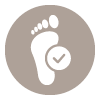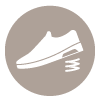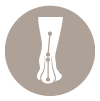Correct Fit
THE IMPACT OF CORRECT FIT FOOTWEAR
Sponsored by

Feet are the body’s foundation, and just like the foundation of any structure, they must be supported to ensure optimal function.
Amazingly, the foot is comprised of bones, muscles, tendons, ligaments, nerves, blood vessels and skin, all working together. The feet provide shock absorption, balance and stability, spring and propulsion, moving into different positions to carry out each of these functions in the walking cycle. When our feet are in neutral alignment, our body is balanced and we function at our best.
Feet are the first part of the body to experience the forces generated during walking and the way in which these forces are distributed can impact and place inevitable stresses and strains on other parts of the body.
The feet have numerous roles to play when walking, they need to absorb the shock when they hit the ground, they need to be flexible and maintain balance when standing on uneven surfaces and they need to provide the spring and propulsion to take a step, moving the body forwards.

THE CORRECT FIT, EVERY TIME.
The human foot was originally ‘designed’ for walking on natural surfaces like soil and sand. Instead we give our feet a daily beating by walking and standing on hard, flat and unnatural surfaces like pavements and floors. This causes our feet to flatten and twist or “excessively pronate” to make ground contact. Like the foundation of a tall building, problems in your feet can have far-reaching effects throughout the body and commonly cause heel pain, aching legs, knee pain – even back pain!
Prioritising foot health is vital to overall body health. There are many short and long term problems that can negatively affect the entirely body if ignored. These include :

FLAT FEET.
FACT– A true flat foot is very rare.
Our feet flatten when we walk due to the hard flat surfaces. This foot type is actually "Functionally Flat"

CALLUS & CORNS.
Thick, hardened layers of skin that develop when your skin tries to protect itself against friction and pressure. They often develop on the top of toes and under the foot

HEEL SPUR, HEEL PAIN (and Plantar Fasciitis).
The most common cause of under the heel pain is inflammation of the tissue that runs along the bottom of the foot; the plantar fascia (plantar fasciitis). Pain is felt in the centre of the heel when weight is placed on the foot, and this stabbing or burning pain is usually worse when taking the first two steps in the morning or after periods of inactivity. The pain can gradually decrease with walking.
Pain at the back of the heel can often be due to over use and tension in the Achilles tendon (the band that connects the calf muscle to the heel). Pain can usually be felt during activity and can also be worse when standing in the morning or after periods of rest.
Achilles tendinitis can be related to excess pronation as this can cause the heel bone to tilt, and so place extra strain on the Achilles tendon which is attached to it. Plantar fasciitis can be related to excess pronation as this will cause more flattening of the arch and stress on the plantar fascia

BUNIONS.
Combination of genetic factors and "excess pronation". A bony bump that forms on the joint at the base of the big toe.

JOINT AND LOWER BACK PAIN.
Joint pain can be related to excess pronation as the position and motion of the lower joints is directly related to the position and motion of the foot: When the foot excessively pronates, the hip position changes and the leg rotates inwards. This can lead to additional stresses on the joints, unnecessary pain and over compensation and pressure on other parts of the body.
Lower back pain is a common disorder involving the muscles, nerves and bones of the back. Pain can vary from a dull constant ache to a sudden sharp feeling. When our body is out of alignment this puts additional pressure on the back and other lower body joints to compensate.
When shopping for footwear, it is important to remember to buy shoes that fit well and support the feet and the arch. At Natural Fit Footwear, we take the time to fit shoes to best suit your activity and conditions.
To help you choose the right shoe, we have a range of icons helping you fit the shoe to your needs and to get the “correct fit, every time”.










